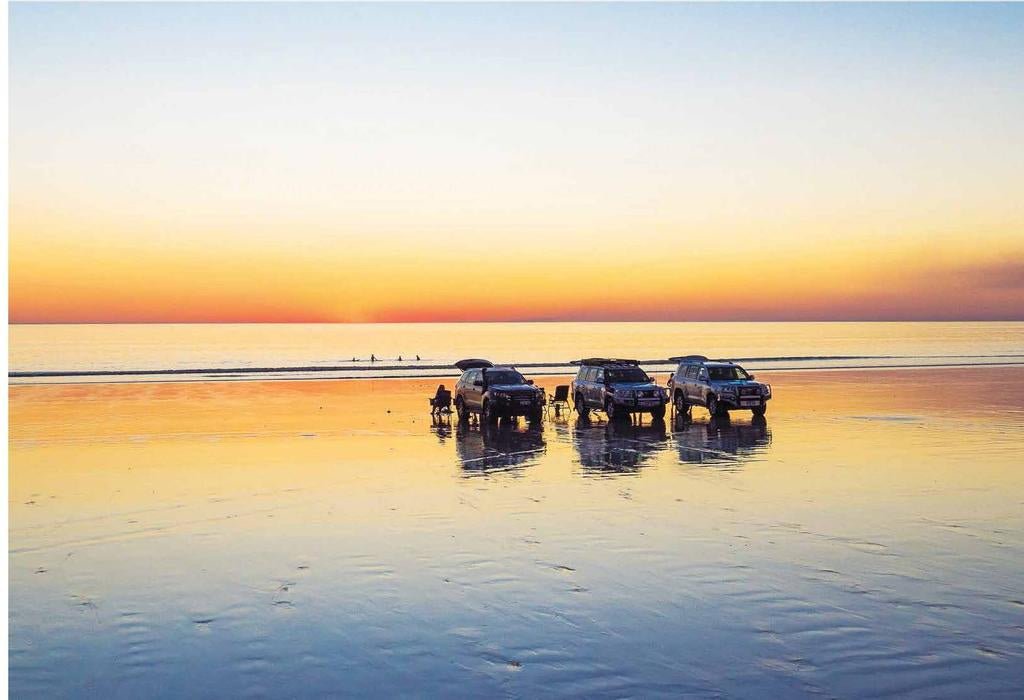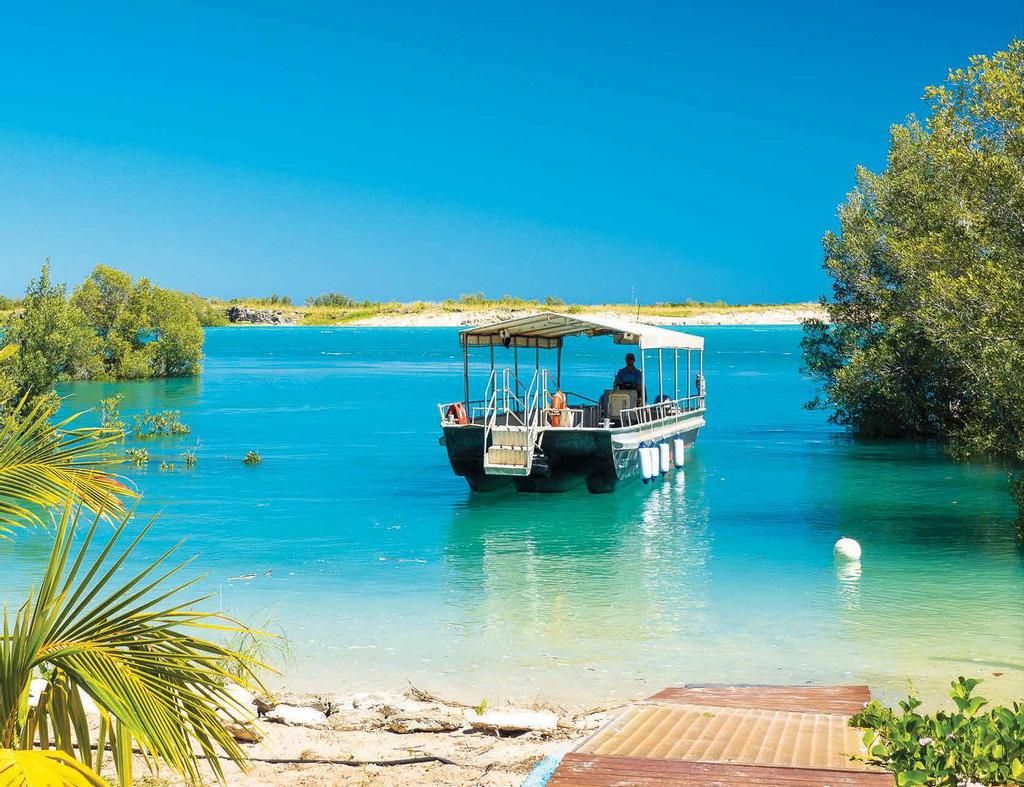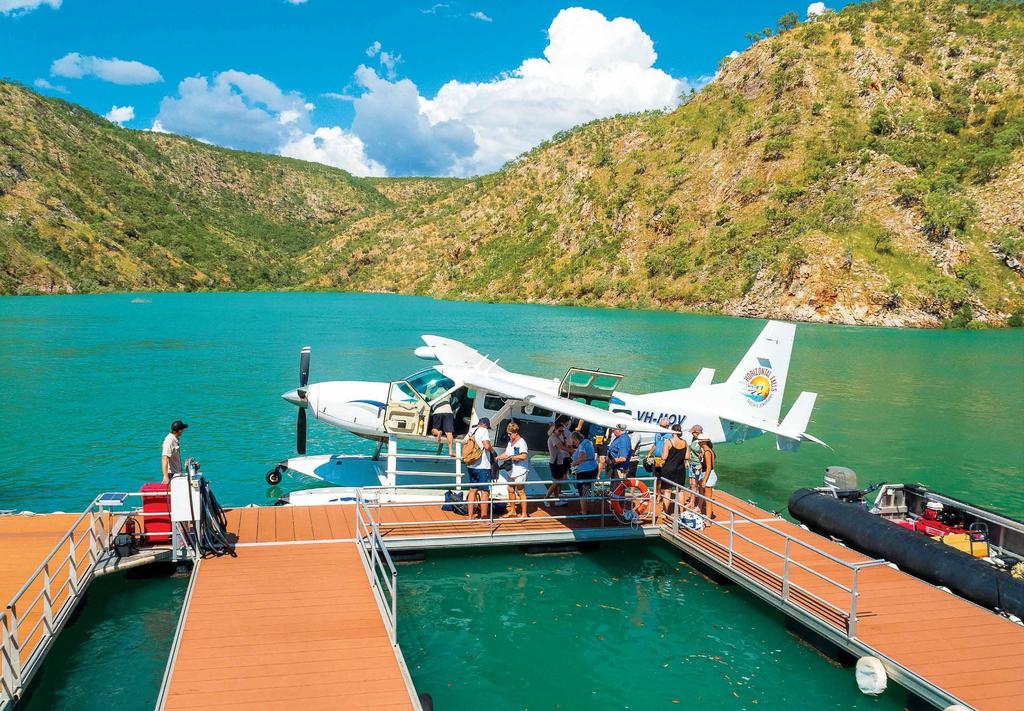The Beauty of Broome

As we walk along the pearl-shop dotted Dampier Terrace, Chris explains that as the 1800s rolled on, pearling camps were established along Dampier Creek, to our right. The newcomers had discovered an optimal location, with freshwater springs at one end and a giant seafood restaurant and moneymaking venture at the other. Word continued to spread, and the ensuing activity spurred the development of modern-day Broome.
Indigenous people, however, had been living in what they called Rubibi long before ‘Broome’ existed — somewhere in the order of 60,000 years. From Kennedy Hill, the Yawuru people saw lugger after lugger roll into the bay from the south, then watched and suffered as those same people took away their livelihoods and forced them into servitude as the pearling industry grew, with pregnant Indigenous women considered the best pearl divers of all.
The Indigenous people became part of a multicultural workforce alongside people from Japan, China, Malaysia, the Philippines, Indonesia and Timor. The migrants became so integral to the local economy that they were granted exemptions when the White Australia policy was introduced, and they left Broome with a legacy of Asian influence, which is noticeable as we walk through Chinatown (formerly known as Japtown).
In its early heyday, Broome had little connection to the rest of Australia, but had a fortnightly shipping service to Singapore, from where many of Broome’s pearl shells were exported. (Back then, it was the mother of pearl shell that was prized, not the pearl itself, and at one point, Broome was responsible for 80 per cent of the world’s buttons, which were made from pearl shell before the advent of plastic.) The Singaporeans also took care of the pearl masters’ washing, given Broome’s pervasive red pindan soil made it impossible to return crisp whites from the wash cycle.
THE PEARL OF THE WEST
Pearling is what put Broome on the map, and the pearling industry fuels Broome’s economy to this day. Thankfully, times have changed, and now the Yawuru people are native title holders, and the pearling industry is tightly regulated. Work conditions have very much improved, though, as we find out when we visit Willie Creek pearl farm, harvesting pearls is still quite a slog.
We take a 4WD bus from town for the 38km trip to the farm and, for the last part of the journey, enjoy what the locals call a ‘Kimberley massage’ as we bump our way down a red-dirt road. (A self-drive option is available, but a 4WD is recommended.)
We’re welcomed by tour guide Lisa Stockman, who shuffles us into the onsite hatchery, promising that we’ll be pearl experts by the time we leave.
The Banfield family, which owns and operates Willie Creek Pearls, is one of a handful of commercial pearling license holders in Australia, and produces Australian South Sea Pearls, cultured in the Pinctada Maxima oyster. The nutrients and minerals found in the warm waters off Broome lead to the development of what are considered the largest and finest quality pearls in the world.

Pearls thrive in Broome's warm, rich waters
We learn about the spawning of oysters in the hatchery and the process of introducing a nuclei into the oyster, which prompts the oyster to cover the irritant in ‘nacre’ to protect itself. Layers of this secretion create a pearl. The process is intricate and fascinating, and we come to appreciate the high price tag of a cultured pearl, particularly when Lisa explains the need to regularly clean barnacles off the oyster shells. “By the end of the day, you look like an oyster, smell like an oyster and end up covered in things you don't want to be covered in,” she says.
After our lesson, we pile into an open-air boat to putter down Willie Creek — a tidal estuary — and see the oysters in their saltwater habitat, placed into panels attached to ropes.
Lisa tells us to take note of the waterline when we set off. If Broome’s main claim to fame is its pearls, its enormous tides run second. During our visit, we witness the tail-end of a 10.3m tide, which swells the creek during our short boat tour, covering the stairs and jetty by the time we pull back into shore.
Our tour progresses to a small shed, where the excitement builds. We’re about to watch the extraction of a pearl from the shell, which will be priced on the spot. It’s not intended to be a competition, but it is. We’re told that the group the day before pulled out a real ‘pearler’ with a price tag of $11,900.
Gloves on and scalpel in hand, Lisa prises open the shell and makes a small incision, carefully digging around until a shiny white pearl pops out. You can imagine our disappointment when we learn it’s worth a paltry $900.
We do, however, get to parade around in some of the finest pearls in the world in the jewellery shop next door, encouraged by Lisa who continues to quiz us on our pearl knowledge as we examine lustre, shape and complexion. Barking answers like eager school kids, it turns out we are quite the pearl experts by the end.
BEAUTIFUL BAYS
Broome’s turquoise Roebuck Bay is a designated wetland of international importance (under the Ramsar Convention) and up to half a million waders and more than 100,000 other migratory shorebirds frequent the area. There’s also plenty of marine life, including three species of sea turtle, dugongs, coastal manta rays and migrating whales. One of the most curious creatures, however, is the snubfin dolphin.
At Entrance Point, we join a boat tour with Broome Whale Watching to go in search of the world’s only resident population of snubfins. As we cruise across the bay, eyes peeled for grey shadows, we spot a black and silver-striped sea snake lazily drifting on the surface. Though definitely not a dolphin, it gives everyone a little buzz as we continue to scan the water for other signs of life.
Finally, our skipper spots a small pod up ahead, and we race across the boat to watch three snubfin dolphins cautiously surface and plod face-first back into the water. Unlike their gregarious bottlenosed cousins, snubfins are shy and slow, and their stubby snouts and beady eyes almost look cartoonish. The family poke their heads up again, long enough for us to take some snaps, then disappear from view. Though our glimpses of the local wildlife are fleeting, cruising around the bay under blue skies and bright sunshine is a more than satisfactory way to spend the morning.
Another of the Kimberley’s famous bays is located a little further away, so the following day, we rise early to visit the place once described by Sir David Attenborough as Australia’s most unusual natural wonder, via air.
Our Horizontal Falls Seaplane Adventures tour starts with a 4WD bus ride to Cape Leveque — a postcard-perfect location with a burnt orange landscape leading into fine white sand and a holiday-blue sea. While most of the 200km road from Broome to the cape has been sealed, the final section still offers a Kimberley massage (so a 4WD is recommended if you decide to self-drive).

Horizontal Falls Seaplane Adventures are a great way to get a bird's eye view of the incredible region
Our tour includes a hot breakfast and a stopover at an Indigenous-run hatchery at One Arm Point, from where we board our 14-seat Cessna seaplane to make the 30-minute journey to Horizontal Falls.
At 2000 feet, the view of the Buccaneer Archipelago is spectacular, with clusters of islands on one side and green ranges on the other. After getting a bird’s-eye view of the two ‘horizontal’ waterfalls gushing beneath us, splaying out like lace skirts against the deep blue of the bay, we steadily descend between steep cliffs and skim across the water before pulling into a pontoon.
The Kimberley’s epic tides are responsible for Talbot Bay’s Horizontal Falls. Essentially, water comes in faster than it can make its way out, creating a waterfall effect, with a drop of up to four metres. What makes the falls even more fascinating is that they’re reversible. Every six hours, with the changing of the tide, the falls stop dead, then gather speed as they start rushing in the opposite direction.
The largest of the two falls, the ‘wide gap’, measures 20m across, and, after we step into a custom-built speedboat at the pontoon, our skipper Taj Rowe pulls away and revs the engine, preparing to zip through water that’s squeezing through the gap at one million litres per second.
“Hold onto your hats, everyone.” Taj speeds through the opening and our boat dips into the adjoining bay with a splash and the thrill of a theme park ride.
The narrow gap, just 7.5m wide, is more treacherous to pass, so we stop short of the falls and take pictures from a safe distance.
In contrast to the wild water feeding the falls in Talbot Bay, nearby Cyclone Creek is pleasantly calm, named for its reputation as a safe anchorage in stormy weather. After a barramundi lunch, we jump back in the boat and Taj takes us for a scenic cruise down the creek. Towering orange cliffs contrast the turquoise water, their diagonal, wave-like ripples the result of sedimentary rock buckling and folding under the weight of millions of years. It feels like a special, hidden corner of Australia and one that’s a privilege to visit.
BROOME ICONS
Broome has a few pin-up images. One is of the burnt orange landscape contrasted against the bluest of blue water (check out Gantheaume Point for that, a spot also known for its dinosaur footprints), another is a caravan of camels plodding along the white sand of Cable Beach (we joined a tour with Red Sun Camels), and another is the ‘staircase to the moon’, best viewed from the large outdoor area of the Mangrove Hotel.
The staircase to the moon phenomenon takes place when a full moon rises over the tidal flats of Roebuck Bay, which occurs two to three days per month between March and October (check the Broome Visitor Centre for dates and times). Our trip is timed for a staircase viewing, so we head to the hotel in the late afternoon to secure a prime viewing position.
Fairy lights twinkle between palm trees as we watch the sunlight gradually fade to make way for Mother Nature’s night-time show. At around 7:30pm, the moon makes its dramatic entrance over the inky water, casting a stepped reflection on the ripples of the ocean. The fence is lined with onlookers, and all eyes are focused on the lunar glow before us.
If only William Dampier had had a smartphone, his snaps of the giant moon and shimmering water would have most certainly gone viral.
THINGS TO DO
There are many things to do in Broome, but a few things to definitely stick on your list are:
NARLIJIA EXPERIENCES BROOME
There are a variety of tours on offer for the Narlijia Experiences. You can take in the Town Tour and also the Mangrove Tour or Bagul Bagul Tour, where you will experience the mangrove forest and hear about the traditional uses of mangrove wood.
Hosted by owner Bart Pilgrim, a Yawuru man from the West Kimberley region is born and bred in Broome. As part of the Pigram-Puertollano family, Bart belongs to a long tradition of pearling workers and musicians, and has many rich and fascinating stories of life around the beautiful turquoise waters of Roebuck Bay, Broome.
For more info, visit toursbroome.com.au/.
ARDI CULTURAL DRIVE
Jump on this 6 day tour and learn all about the land and culture of the people of the Dampier Peninsula. Join local guides to explore Bardi and Nyul Nyul country and learn there is more to this area than scenic beaches and turquoise waters.
For more info, visit australiasnorthwest.com/explore/broome-dampier-peninsula or westernaustralia.com/en/Itinerary/The_Ardi_Cultural_Drive/5ac5fd989dce72a67bd6c5b8.
WILLIE CREEK PEARLS
Family owned and operated, the Willie Creek Pearl Farm Tour takes visitors on a journey back in time. Visit Pearl Luggers museum or harvest your very own pearl in Perth at Elizabeth Quay. From telling the story of history and pearling in Broome to modern day pearling, commercial pearl farming and jewellery, the team will share every part of the unique story of the Pearl of Western Australia.
At Harvest kitchen at Willie Creek Pearl Farm, The Lugger’s Galley at Pearl Luggers and at The Zookeeper's Store at Cable Beach, you can even taste the rare delicacy of pearl meat!
For more information, visit williecreekpearls.com.au/.
FAST FACTS
GETTING THERE
You can drive to Broome from Perth in around seven days, taking in Nambung National Park, Geraldton, Kalbarri, Monkey Mia, Carnarvon, Coral Bay, Karratha, Port Headland and Eighty Mile Beach.
WHEN TO TRAVEL
Broome gets some torrential rain during the wet season, so it’s best to visit between April and November.
EAT & DRINK
Enjoy an Asian-inspired lunch at The Aarli, creative craft beers at Matso’s brewery (try the chilli ginger beer for a kick), and a pizza at the famous Roebuck Bay Hotel, better known as ‘the Roey’, which was founded in 1890 and became the local haunt of Broome’s pearling crews. Zanders is good for a seafood platter after a camel ride on Cable Beach.
STAY
There are a number of caravan parks in Broome, including Cable Beach Caravan Park, RAC Cable Beach Holiday Park, Discovery Parks – Broome, and Tarangau Caravan Park.
CONTACT
Broome Visitor Centre
1 Hamersley Street, Broome
Ph: (08) 9195 2200
E: enquiries@visitbroome.com.au







